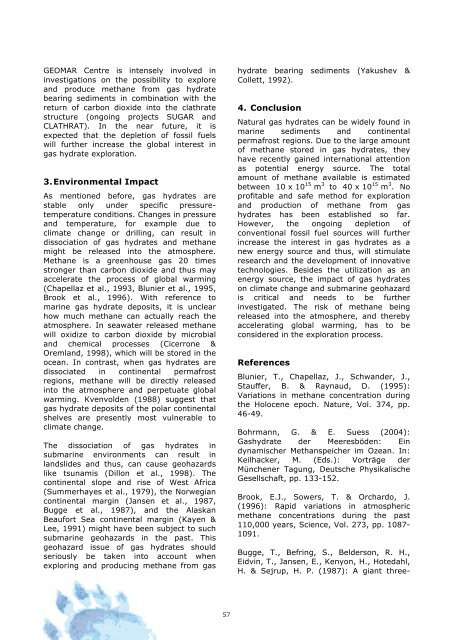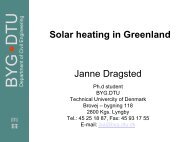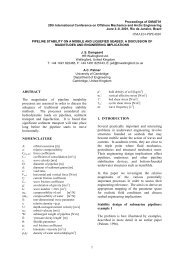Energiforsyning i Arktis – hvilken vej vælger Grønland? - Artek ...
Energiforsyning i Arktis – hvilken vej vælger Grønland? - Artek ...
Energiforsyning i Arktis – hvilken vej vælger Grønland? - Artek ...
Create successful ePaper yourself
Turn your PDF publications into a flip-book with our unique Google optimized e-Paper software.
GEOMAR Centre is intensely involved in<br />
investigations on the possibility to explore<br />
and produce methane from gas hydrate<br />
bearing sediments in combination with the<br />
return of carbon dioxide into the clathrate<br />
structure (ongoing projects SUGAR and<br />
CLATHRAT). In the near future, it is<br />
expected that the depletion of fossil fuels<br />
will further increase the global interest in<br />
gas hydrate exploration.<br />
3. Environmental Impact<br />
As mentioned before, gas hydrates are<br />
stable only under specific pressuretemperature<br />
conditions. Changes in pressure<br />
and temperature, for example due to<br />
climate change or drilling, can result in<br />
dissociation of gas hydrates and methane<br />
might be released into the atmosphere.<br />
Methane is a greenhouse gas 20 times<br />
stronger than carbon dioxide and thus may<br />
accelerate the process of global warming<br />
(Chapellaz et al., 1993, Blunier et al., 1995,<br />
Brook et al., 1996). With reference to<br />
marine gas hydrate deposits, it is unclear<br />
how much methane can actually reach the<br />
atmosphere. In seawater released methane<br />
will oxidize to carbon dioxide by microbial<br />
and chemical processes (Cicerrone &<br />
Oremland, 1998), which will be stored in the<br />
ocean. In contrast, when gas hydrates are<br />
dissociated in continental permafrost<br />
regions, methane will be directly released<br />
into the atmosphere and perpetuate global<br />
warming. Kvenvolden (1988) suggest that<br />
gas hydrate deposits of the polar continental<br />
shelves are presently most vulnerable to<br />
climate change.<br />
The dissociation of gas hydrates in<br />
submarine environments can result in<br />
landslides and thus, can cause geohazards<br />
like tsunamis (Dillon et al., 1998). The<br />
continental slope and rise of West Africa<br />
(Summerhayes et al., 1979), the Norwegian<br />
continental margin (Jansen et al., 1987,<br />
Bugge et al., 1987), and the Alaskan<br />
Beaufort Sea continental margin (Kayen &<br />
Lee, 1991) might have been subject to such<br />
submarine geohazards in the past. This<br />
geohazard issue of gas hydrates should<br />
seriously be taken into account when<br />
exploring and producing methane from gas<br />
57<br />
hydrate bearing sediments (Yakushev &<br />
Collett, 1992).<br />
4. Conclusion<br />
Natural gas hydrates can be widely found in<br />
marine sediments and continental<br />
permafrost regions. Due to the large amount<br />
of methane stored in gas hydrates, they<br />
have recently gained international attention<br />
as potential energy source. The total<br />
amount of methane available is estimated<br />
between 10 x 10 15 m 3 to 40 x 10 15 m 3 . No<br />
profitable and safe method for exploration<br />
and production of methane from gas<br />
hydrates has been established so far.<br />
However, the ongoing depletion of<br />
conventional fossil fuel sources will further<br />
increase the interest in gas hydrates as a<br />
new energy source and thus, will stimulate<br />
research and the development of innovative<br />
technologies. Besides the utilization as an<br />
energy source, the impact of gas hydrates<br />
on climate change and submarine geohazard<br />
is critical and needs to be further<br />
investigated. The risk of methane being<br />
released into the atmosphere, and thereby<br />
accelerating global warming, has to be<br />
considered in the exploration process.<br />
References<br />
Blunier, T., Chapellaz, J., Schwander, J.,<br />
Stauffer, B. & Raynaud, D. (1995):<br />
Variations in methane concentration during<br />
the Holocene epoch. Nature, Vol. 374, pp.<br />
46-49.<br />
Bohrmann, G. & E. Suess (2004):<br />
Gashydrate der Meeresböden: Ein<br />
dynamischer Methanspeicher im Ozean. In:<br />
Keilhacker, M. (Eds.): Vorträge der<br />
Münchener Tagung, Deutsche Physikalische<br />
Gesellschaft, pp. 133-152.<br />
Brook, E.J., Sowers, T. & Orchardo, J.<br />
(1996): Rapid variations in atmospheric<br />
methane concentrations during the past<br />
110,000 years, Science, Vol. 273, pp. 1087-<br />
1091.<br />
Bugge, T., Befring, S., Belderson, R. H.,<br />
Eidvin, T., Jansen, E., Kenyon, H., Hotedahl,<br />
H. & Sejrup, H. P. (1987): A giant three-





